Net Promoter Score vs CSAT – Who Wins the Battle?
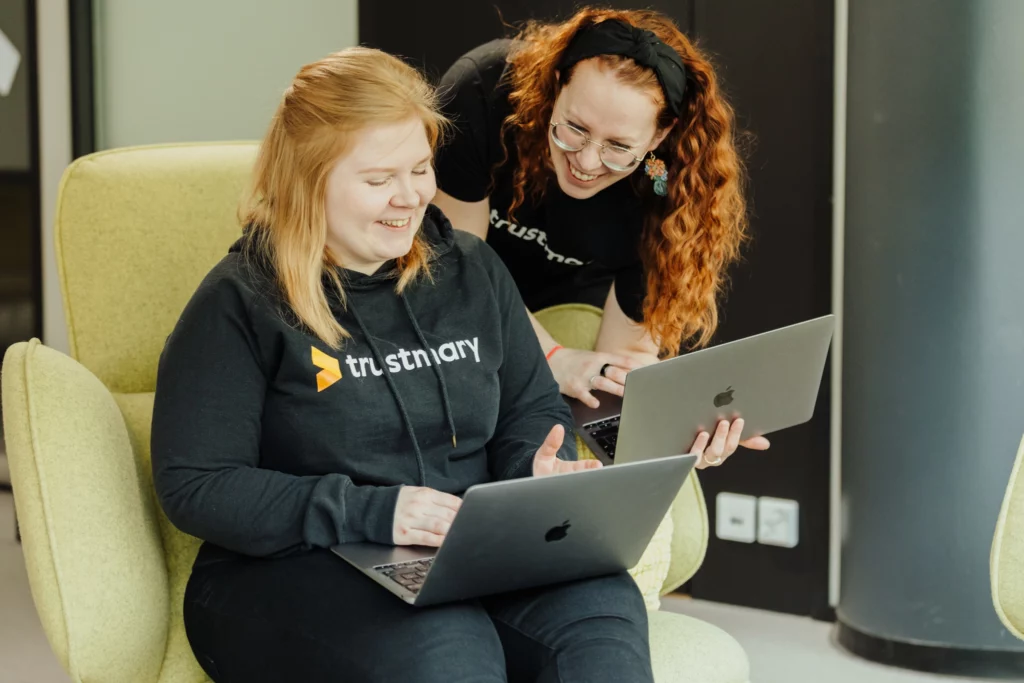
Customer experience is essential for companies to thrive in the modern era.
Even today, companies are unsure of which customer experience metric to use: the Net Promoter Score (NPS) or Customer Satisfaction Score (CSAT)?
Both have their pros and cons and measure different aspects of customer experience, so which one should your company use?
I'll go over each customer experience metric to determine who wins the battle between NPS and CSAT!
What Is NPS
Net Promoter Score (NPS) is a customer loyalty metric that was created by Fred Reichheld, a Bain & Company partner and the author of The Ultimate Question: Driving Good Profits and True Growth.
NPS is calculated by asking customers the following question:
"On a scale of 0 to 10, how likely are you to recommend our company to a friend or colleague?"
Customers who answer with 9 or 10 are considered promoters, customers who respond with 7 or 8 are considered passives, and customers who respond with a 0 to 6 are considered detractors.
The NPS is then calculated by subtracting the percentage of detractors from the percentage of promoters.
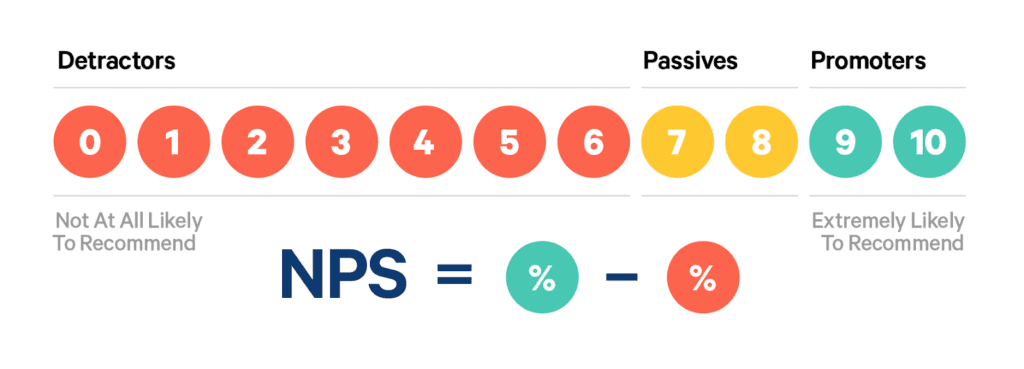
For example, if you have a total of 100 customers and 30 are promoters, 20 are passives, and 50 are detractors, your NPS would be:
Percentage of promoters = 30/100 = 30%
Percentage of detractors = 50/100 = 50%
Net Promoter Score (NPS) = % promoters - % detractors
Net Promoter Score (NPS) = 30% - 50%
Net Promoter Score (NPS) = -20%
Pros and Cons of NPS
There are a few pros and cons of using the NPS metric:
Pros
- NPS surveys are easy to understand and quick to calculate.
- The NPS score can be tracked over time, so you can see if your company is improving or declining in terms of customer loyalty.
- NPS score is a good predictor of customer loyalty and revenue growth.
Cons
- NPS surveys do not take into account the size of a company. A small company with a high NPS could be outperforming a large company with a low NPS.
- NPS surveys do not tell you what is causing customers to be promoters or detractors.
When to Ask the Question
The question should be asked towards the end of the customer's interaction with your company. This could be on a survey, after a purchase, or after using your product or service.
Definition of CSAT
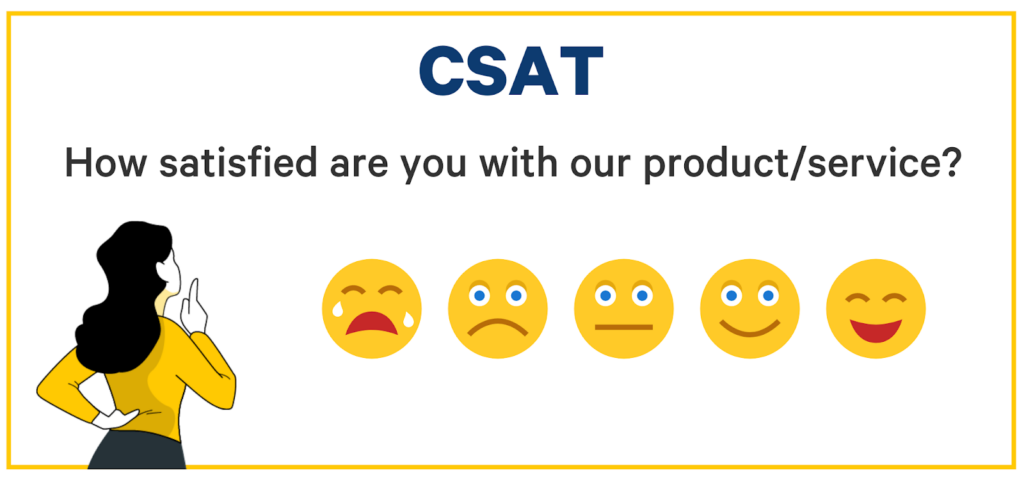
In the fall of 1995, Earl Sasser and Tom Jones discussed the importance of the top-box customer satisfaction score.
Customer Satisfaction Score (CSAT) is a customer experience metric that has been around for many years.
To measure customer satisfaction CSAT, ask customers the following question:
"How satisfied are you with our product/service?"
Customers who respond with a 9 or 10 are considered satisfied, customers who respond with a 7 or 8 are considered neutral, and customers who respond with a 0 to 6 are considered dissatisfied.
The CSAT is then calculated by dividing the number of satisfied customers by the total number of respondents.
For example, if you have a total of 100 customers and 60 are satisfied, 20 are neutral, and 20 are dissatisfied, your CSAT would be:
Satisfied customers = 60/100 = 60%
Dissatisfied customers = 20/100 = 20%
CSAT = % satisfied customers / total number of respondents
CSAT = 60%/100 = 60%
Pros and Cons of Customer Satisfaction CSAT
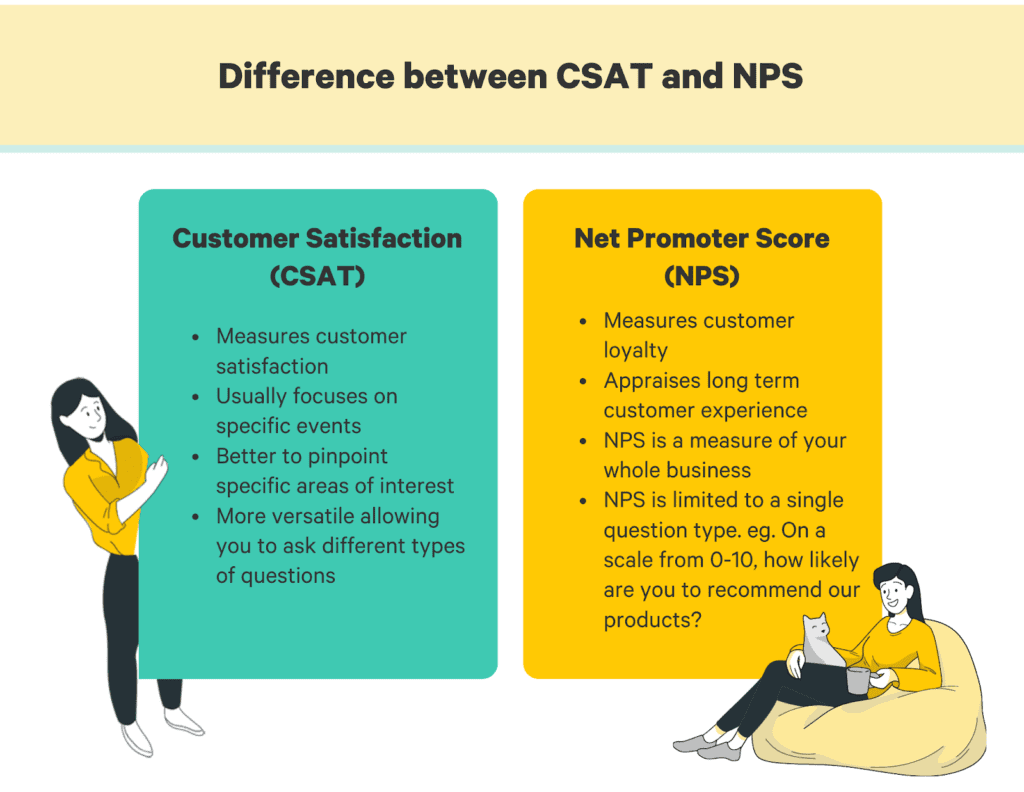
The pros and cons of using the CSAT metric are as follows:
Pros
- CSAT is easy to understand and calculate.
- CSAT can be tracked over time, so you can see if your company is improving or declining in terms of customer satisfaction.
- CSAT helps pinpoint the areas of your product or service that need improvement.
Cons
- Several factors may affect customer satisfaction, so CSAT may not be a good predictor of customer loyalty and revenue growth.
- CSAT does not tell you how likely customers are to recommend your product or service to others.
- CSAT doesn't give you the big picture in terms of customer experience. It would be best if you used other metrics in conjunction with CSAT surveys to understand fully.
When to Ask the Question
It is best to ask this question near the beginning of the customer's interaction with your company.
This could be on a survey when they first purchase from you or after using your product or service for the first time.
Who Wins the Battle Between NPS and CSAT?
By now, we have a basic understanding of the two metrics. However, the question remains: who wins the battle, CSAT vs. NPS?
According to your use case, one metric may be more beneficial than another.
To measure customer satisfaction swiftly, CSAT is the better metric. However, if you are looking for a metric that can predict customer loyalty and revenue growth, then NPS is the better metric.
Let's place these two metrics head-to-head in different scenarios for better insight.
First, we will look at which metric is better for short-term customers. Then, we will consider which one will serve your business better for long-term customers.
Short Term Customer – Which One to Use?
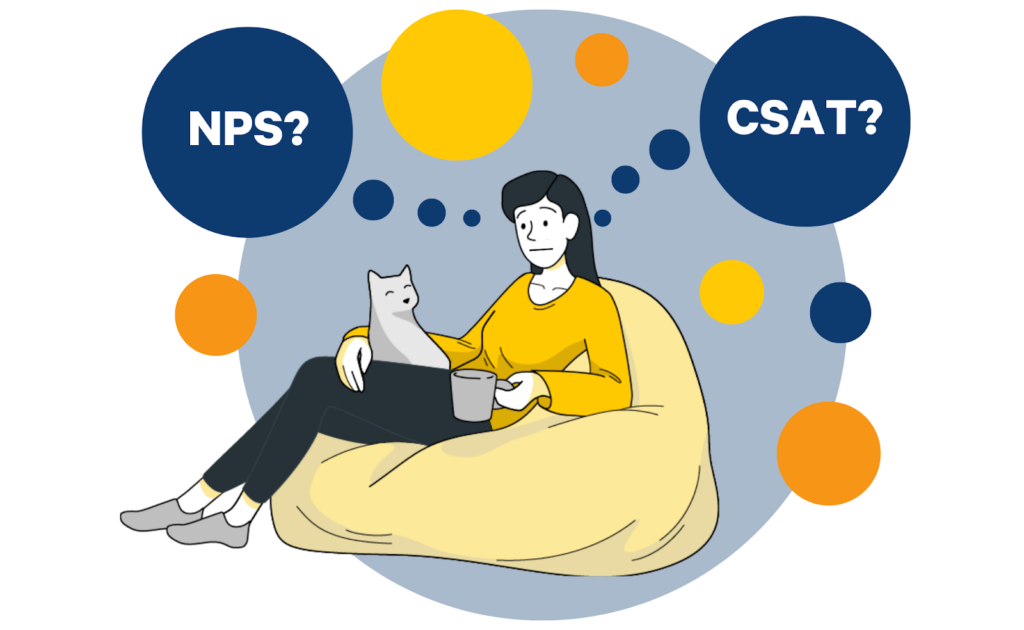
Before we begin, it is vital to understand short-term customers.
As the term suggests, short-term customers are there for a limited time. They might return, but they are not planning on it.
They are typically there for a specific purpose, such as making a purchase or using a service. They don't really care about recommending your product or services. All they need is a quick fix for solving their problems.
Now that we understand short-term customers better let's look at which metric is better for measuring their satisfaction.
For short-term customers, CSAT offers the following:
- Ease of use – Customers can easily answer how satisfied they are with a product or service.
- Quick feedback – Customers can provide quick feedback, which is ideal for companies looking for a fast turnaround.
For short-term customers, NPS offers the following:
- Predicting loyalty – NPS surveys can be used to predict how likely a customer is to return or recommend your product or service.
- Detailed feedback – NPS surveys can offer detailed feedback to help companies understand why customers are loyal or dissatisfied.
In this scenario, I would say that CSAT is the better metric.
The reason is that CSAT only considers how satisfied customers are with the product or service.
Since short-term customers are only concerned with solving their immediate problem, measuring satisfaction is the best way to go.
Furthermore, it's better to make first-time customers happy before increasing their loyalty.
Doing so will increase the chances of returning (or recommending) in the future.
Long Term Customer – NPS vs. CSAT
Now that we have looked at who the winner is for short-term customers, let's look at the winner for long-term customers.
Again, let's define long-term customers first.
A long-term customer is similar to a beloved old friend. You may have had up-and-downs, but they are always there for you. You know you can count on them and vice-versa.
A trendy word for them is fanboys.
They are typically loyal and return customers. They are also more likely to refer your product or service to their friends.
Now that we know who our long-term customers are, let's look at which metric is better for measuring their satisfaction.
Pros of CSAT in Long-Term Cooperations
- Common pain points – CSAT surveys can help identify common pain points that customers are experiencing.
- Measuring improvement – CSAT can track how customer satisfaction improves (or not).
NPS in Long-Term Partnerships
- Predicting loyalty – as mentioned before, NPS can be used to predict how likely a customer is to return or recommend your product or service.
- Detailed feedback – as mentioned before, NPS offers detailed feedback to help companies understand why customers are loyal or dissatisfied.
In this scenario, I would say that NPS is the better metric.
The reason being is that NPS can track how likely customers are to return or refer in the future. It gives a concrete number to customers' loyalty.
It also gives detailed feedback as to why they are loyal or dissatisfied.
Long-term customers can become brand ambassadors, and NPS surveys can help you see which one of them are working to promote your brand.
Quick Summary Of The Battle Between NPS Vs. CSAT So Far
When considering CSAT vs. NPS, a major distinction is that the former is considered a short-term evaluation of customer satisfaction for targeted, iterative enhancements. At the same time, the latter is a long-term metric for customer loyalty.
The difference is clearer when you look at the primary term in the metrics. One measures 'satisfaction', while the other measures 'loyalty.'
Satisfying a customer is often easier than earning their loyalty and trust. The former requires more time and a deeper connection.
To summarize, just because someone is happy with their purchase doesn't imply they'd recommend you to a friend.
Brands frequently utilize NPS to monitor the overall experience quality and CSAT surveys for more targeted service and product feedback.
NPS and CSAT in B2B Context
'Business to business' companies (B2B) have a unique set of challenges and opportunities for customer feedback.
These challenges revolve around the fact that, in most cases, a business sells to another business rather than to individual consumers.
This means that NPS and CSAT scores can be somewhat misleading, as they are not always directly tied to revenue or profit.
For example, a company may have a high NPS score, which means that customers are very likely to recommend them to others. However, this doesn't mean that they are making a lot of money off of these recommendations.
Conversely, a company may have a low CSAT score but be making a lot of money from their customers.
This presents a dilemma for businesses: should they focus on increasing their NPS score, even if it doesn't directly impact revenue?
NPS in B2B

Net Promoter Score (NPS) can be a good indicator of a company's overall reputation. It can help to track the progress of client loyalty over time.
Loyal B2B promoters have an average lifetime value typically three to eight times that of detractors.
Promoters are more likely to recommend the supplier to their coworkers and friends, stay longer with the company, buy extra items, and cost less to serve
According to Bain's research and client work, NPS is strongly linked with sales growth, market share expansion, customer loyalty, salesforce productivity, higher business profits, and reduced customer acquisition costs.
That results in B2B loyalty leaders growing four to eight percentage points above their market's annual growth.
CSAT in B2B
CSAT (Customer Satisfaction Score) is a crucial metric for understanding customer feedback.
In B2B contexts, it can be helpful to look at the CSAT score on a category-by-category basis. That is, measuring customer satisfaction with the product, customer satisfaction with the service, customer satisfaction with the buying process, etc.
B2B companies can use CSAT surveys to understand which aspects of the customer experience are most important to their clients.
They can also use CSAT data to track progress over time and identify areas where they need to make changes to improve customer satisfaction.
To summarize, in CSAT vs. NPS for B2B, both have unique advantages.
- NPS can be used to track a company's overall reputation and measure the progress of customer loyalty over time.
- CSAT score can be used to understand customer feedback on a category-by-category basis.
- CSAT and NPS are both useful metrics for understanding customer feedback and experience. CES can help to contextualize these scores further and understand how they impact revenue and profit.
What about CES?
NPS is a relational measurement, and CSAT is a relational and transactional measurement.
Customer Effort Score (CES) is a transactional metric that can be used to measure how much energy a customer has to put in to get their issue solved.
CES is a good metric for understanding how easy it is to do business with a company.
The critical question asked in CES is, "How much effort did you have to put in to get your issue solved?"
The idea behind measuring the ease or difficulty of doing business with a company is that it can help to identify areas where the company is making it easy or difficult for customers to interact with them.
Furthermore, the easier it is for customers to do business with a company, the more likely they will be satisfied with their experience.
CES is a good metric for understanding how easy it is to do business with a company.
Pros and Cons of CES
CES offers its own pros and cons:
Pros
- CES helps identify disappointed customers who have had a bad experience with your company but did not bother to complain.
- CES can help to identify and eliminate redundancies by providing a standard metric across all customer service channels.
- CES can be used to improve product features and design.
Cons
- CES does not take into account the emotional response of customers.
- CES may be less effective in measuring complex products and services.
- CES does not offer the complete picture of customer satisfaction.
When to Ask CES
CES should be asked after the customer's issue has been resolved.
It is not a good idea to ask CES right after the customer has contacted customer service because they may not have had a chance to resolve their issue fully.
Match Customer Satisfaction Metric to Your Need
Net Promoter Score and Customer Satisfaction Score are both essential metrics for understanding customer feedback.
The Net Promoter Score (NPS) is a relational measurement that may be used to track a company's reputation and the rate of customer loyalty over time.
Customer Satisfaction Score (CSAT) is a relational and transactional measurement that can understand customer feedback and their level of satisfaction.
The Customer Effort Score (CES) is a transactional metric that can measure how much struggle a customer has to go through to get their issue solved.
| Pros | Cons | |
| Net Promoter Score NPS | Easily identify happy customers and measures customer loaylty | Need additional analysis of the open feedback |
| Customer Satisfaction Score CSAT | Great in evaluating specific touch point or processes | Doesn't measure loyalty |
| Customer Effort Score CES | Measuring is fast, mostly in real-time. Short-term feedback. | Only measures one aspect, and results can't (and shouldn't) be generalized. |
CSAT takes the win for short-term customers due to its ability to track satisfaction in a single interaction.
NPS takes the win for long-term customers due to its ability to track loyalty and reputation over time.
Even though they measure different things, you can (and should!) use them both! Most importantly, try to find NPS software or CSAT software that can help you automate the whole process.
The best customer satisfaction software naturally includes both NPS and CSAT in one tool.
If the Salesforce NPS solution is too expensive, try Trustmary!
It's more cost-effective, and more versatile.
Ideas for further reading
Trustmary Blog
Ultimate Guide To Customer Experience
Net Promoter Score: The Definitive Guide to NPS
7 Best CSAT Software for Measuring Customer Satisfaction
Actionable Guide to Measuring and Analyzing Customer Satisfaction in 2024
Other Reading
Customer experience quality surpasses NPS in correlation to financial performance, customer loyalty, and customer satisfaction, Michele Bennett, 2020.
FAQs
Which is better for customer experience, NPS or CSAT?
Both NPS and CSAT are essential metrics for understanding customer feedback. However, which one is better depends on the situation.
- NPS is better for measuring loyalty and reputation over time for the business as a whole
- CSAT is better for understanding customer satisfaction in a single interaction
Can I use both NPS and CSAT together?
Yes! You can and should use both metrics together to understand customer feedback thoroughly.
You can ask the 'NPS question' in CSAT surveys to better understand your customer, and vice versa.
What is the Customer Effort Score (CES)?
The Customer Effort Score (CES) is a transactional metric that can measure how much friction a customer has to experience to get their issue solved.
CES is ideal for measuring the customer experience with a company, as it considers how easy it is to do business with a company.
What are good examples of CSAT and NPS scores?
- A good CSAT score is anything above 75%.
- Some people say a positive NPS score is good enough. That said, industries usually aim for a score that is above 60.
Remember, these scores change with respect to the industry and company. Refer to ASCI for a detailed breakdown of industry-specific scores.
Which metric is better for my company?
That depends on the situation!
- If you want to gauge customer experience for short-term customers, use CSAT.
- If you want to gauge customer experience for long-term customers, use NPS.
- If you want to use a metric that considers how easy it is to do business with your company, use CES.
